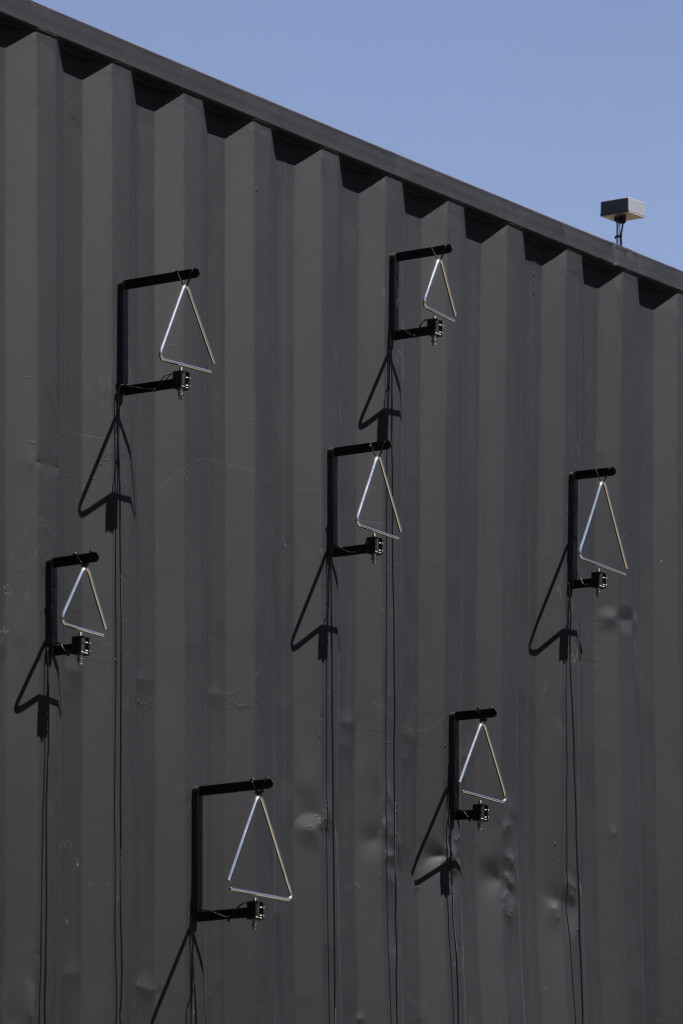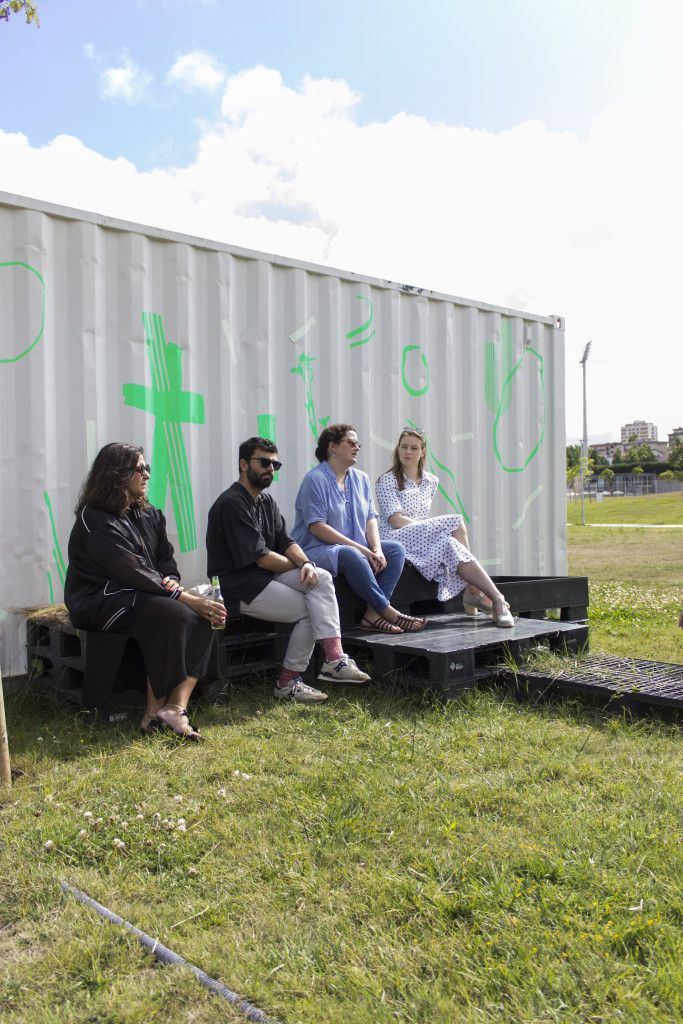
Performance by Acro Clube da Maia in front of AATB’s “A Particular Score” installation. Photo by Rita França.
When Andreia Garcia invited me to curate the Design program of the 2019 Maia Biennial of Contemporary Art, which she was overseeing as chief curator, I was overjoyed for a number of reasons. First, here was an opportunity to work in my home country of Portugal for the first time in ten years; second, it allowed me to stretch the definition of what is design in an event that just incorporated in its program; and finally, it gave me the opportunity to commission new work to some of the most interesting designers working in Portugal and abroad at the moment. I was thrilled to be able to develop new work with AATB, Catarina Carreiras, Orlando Lovell and Pedro Augusto, and had a lot of fun curating the design program of the biennial with Inês Revés. Below an excerpt of the essay detailing the curatorial approach, and more details on each commission after the jump below.
In post-industrial, twenty-first century Europe design is facing a transitional moment. Born with the Industrial Revolution, this discipline experienced a moment of great abundance after the post-war reconstruction boom of the 1950s. The capitalist explosion of the mid-twentieth century brought along the fiction of endless growth. We now know – after the hard consequences of the last two decades – that this was not true. Among financial crises, global warming, the potential failure of the European project and mass layoffs, the context in which the discipline emerged is no longer extant. We face a brave new world in which crisis spread to the point of becoming a quasi-permanent state of affairs, and in which the confrontation of preceding decades will no longer exist. At this moment, we must question all certainties of the last hundred years in order to dream and invent what is yet to come, and to test out a future that we are unable to envision.
In this context, design has met with an impasse, a moment of profound questioning in which the questions that were always answered no longer make sense and the silos of specialization into which it developed are increasingly less relevant. Today, graphic and product design have expanded to encompass other fields and disciplines as new specializations take shape with abstract names such as conceptual design, speculative design, biodesign, social design. Designations aside, what unites these new areas is a sceptical, questioning attitude regarding what design is and what it could be. At the same time, the new ramifications of design are not enclosed in a single disciplinary silo but seek dialogue and mediation with other disciplines – from the social sciences to biology, from economy to literature. This is the advent of a new mentality and new priorities for this disciple: on the one hand, it has realized that its initial objectives are not sustainable; on the other, it recognizes that this is a moment for reinvention and opportunity.
Today, design works with other disciplines as a mediating discipline. It takes on multiple forms and scales, it is visible and invisible, it does not necessarily generate objects or solutions, but interactions, connections and possibilities. Above all, it generates many – if not all – of our interactions with the world, from the technology that we carry in our pockets every day to our relationship with our governments, distribution systems and one another. In doing so, it is a platform for deep experimentation and, most of all, a meeting point.
The Maia Biennial of Contemporary Art’s disciplinary axis of Design also wants to be a meeting point, a stage for sharing, for knowledge, for points of view and modes of producing. In doing so, it carries with it the contemporary reality of design, proposing new ways of making design. Guest participants have all presented new commissions. Two of them manifest formally and occupy the territory with large-scale installations; two other manifest invisibly through interactions with the territory and its inhabitants to generate unexpected unforeseen and multi-sensorial results. All of these are modes of making design; and they are all pathways for contemporary design.

Detail of AATB’s A Particular Score. Photo by Tiago Casanova.
AATB – A Particular Score
Cosmic rays are high-energy radiation, originating outside the Solar System in more distant galaxies. A significant fraction of primary cosmic rays originate from the supernova explosions of stars. Upon impact with the Earth’s atmosphere, cosmic rays can produce showers of secondary particles that, at times, reach the surface of the Earth. For A Particular Score, studio AATB makes visible through an audio score the secondary particles that impact this specific location, in real time.
The installation responds to the impact of these secondary particles by playing a note every time a particle hits the container. The score progresses with each particle hit, taking the score one note forward and producing an irregular beat. The monolithic volume contrasts with the lightness of the sound; together, they make visible processes that are all around us, are much bigger than us, and bring us forward in the same way the universe moves all around us – inexorably.

Catarina Carreiras – Assembleia. Photo by Rita França.
Catarina Carreiras – Assembleia (Assembly)
With Assembly, designer Catarina Carreiras creates a space for encounters that welcomes different kinds of use, opening up possibilities with each day.
Assembly – literally, a meeting or gathering of people with a specific goal in common – is designed to invite and make possible a variety of formats and events throughout the biennial, formalized by the program or informal and spontaneous. The space is formed and designed in response to the context and the contrasts found during a research period: the rural vs. the industrial; the two-dimensional vs. the three-dimensional; the encounter of ideas vs. their confrontation; the exterior vs. the monolithic block of the container; and the thread vs. the line. Assembly seeks to bridge gaps between the rural past of Maia and its industrial present, in an assemblage of materials that conduct ideas.

Orlando Lovell – Counter Cookie-Cutter Culture. Photo by João Garcia
Orlando Lovell – Counter Cookie-Cutter Culture
In every country there are stories old and new. We often used to share some of these stories through the food we ate, breaking certain breads and eating certain biscuits or cakes with a history on specific dates or for certain meals. But industrialised and globalised food production has turned many traditional narratives stereotyped or formulaic, using them as advertising tools specifically aimed towards and adapted for selling more produce. This means local stories that don’t sell so well or don’t fit the mould are often left behind and forgotten.
Such as a traditional biscuit from the city of Maia, in Portugal, called Biscoito Maiato that is shaped in the form of swords and shields, relating to tales of local patrons and warriors from the 12th century. Disconnected from modern-day sentiments and its story, the Biscoito Maiato has fallen out of favour with locals. Through a polycreative process, involving multiple creative stages and actors, such as a local school class, a graphic designer from Porto and a craftsman from Lisbon, we aim to reinvent this ancient biscuit recipe together and give it new shapes based on their own histories and modern legends. This project is about bringing new stories to light and translating them into edible experiences, thereby creating new traditions from stories that are shared by today’s younger generation. We will collect their tales and help them translate them into edible shapes to be shared and savoured.

The “Temas Maiatos” three-cassette edition. Photo Pedro Augusto.
Pedro Augusto – Temas Maiatos / Maia themes
Temas Maiatos(Maia themes) is a radio program developed from interviews and collections carried out between March and July 2019. It translates, in a format closer to the libretto, the synchronous description of marginal anthropological episodes, promenades around the town’s geography and observations focusing on: psychic phenomena, vernacular architectural manifestations and some animalia, in three episodes of monthly periodicity.
Here, special attention is paid to marginal figures and outsider manifestations, obscure chapters and the linguistic idiosyncrasies of the lands of Maia, always in dialogue with the diachronism of ethnographic and oral strain, that history set aside.
Download or listen to the three episodes here.

Going deeper into the process and motivations behind the design projects with Catarina Carreiras, Pedro Augusto and Orlando Lovell. Photo Miguel de Oliveira.
This project was kickstarted by the Maia Municipality and by Andreia Garcia’s (chief curator) kind invitation to join a team of curators alongside Diogo Aguiar and Javier Peña Ibáñez (architecture); Luís Albuquerque Pinho and Luís Pinto Nunes (visual arts); and Sara Orsi (new media). The design projects would not have happened if it wasn’t for the unwavering support of Inés Revés (assistant curator design), as well as the enthusiasm of all participating designers/artists: AATB, Catarina Carreiras, Pedro Augusto and Orlando Lovell. We worked with varied local partners, such as the Acro Clube da Maia, Edisco and Maiadouro, and had the support of a variety of institutions, such as the Secondary School of Castêlo da Maia (Pastry Course) and the Goethe Institut Porto. Thank you to all!